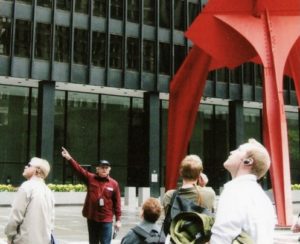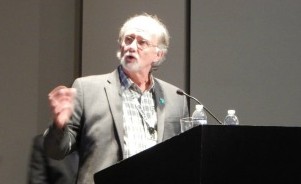By Brent Hoffmann, Class of 2005

“Tourees often ask me how our Bloomingdale Trail, the heart of Chicago’s 606, compares to the High Line in New York City,” said John Paige, co-director of CAC’s Walk the 606. “Both are very old elevated urban railroad viaducts that pass through vibrant dense historic neighborhoods,” he explained. “Each has been carefully and cleverly remade into beautiful urban trails that are heavily used and enjoyed by walkers and joggers. I often add, just for fun, especially if I learn a New Yorker is on my tour, that the 606’s length is 2.7 miles—longer than the New York Highline’s 1.45 miles. The 606 allows bicycling where the Highline does not. Chicago’s 606 permits pets where the Highline does not. The 606 is designed for ‘universal accessibility,’ and I’m pleased and proud to say that I gave the tour for a person in a wheelchair.”
John’s a natural for directing this tour. He is a long-time advocate for increasing walking and bicycling in Chicago. As the planning director for Chicago’s regional planning agency, where in the 1980s, he developed the first bicycle and trail plan for the Chicago metropolitan region. He is a board member of the 606 Park Advisory Council and active with Chicago’s Active Transportation Alliance. Said John, “I don’t own an auto, so I do most of my local travel in the city by bicycle or by walking. I also enjoy travel by CTA bus and rail.”

Civil Engineering & Public Policy
“While I grew up in Gary, Indiana, I was a Chicagoan-in-training early in life,” Paige continued. “I became a White Sox fan in 1959. That also was the year I played Little League baseball, and we won the Indiana Little League State Championship. I delivered the Chicago Daily News in Gary when I was 13 years old. I took the South Shore railroad into Chicago to visit the museums and to go to White Sox games, and even a Cub game or two.” In high school, John excelled at math and science, so he chose Purdue University, in West Lafayette, Ind., where he earned undergraduate and grad degrees in civil engineering and public policy.
“My first job out of college was with an engineering firm in Washington, D.C, where I worked on traffic studies. I then worked a couple of years for the Connecticut Department of Transportation, helping set up their state-wide commuter park-and-ride program. After that, I worked for two years for Hartford, setting up a small, six-bus ‘dial-a-ride’ bus system for Hartford’s elderly and handicapped residents. In 1975, I was recruited by the Northeastern Illinois Planning Commission’s Chicago office and, eventually, became its director of planning. In 2005, I retired from the Commission.”
John is a member of the American Institute of Certified Planners (AICP). He was recognized as an AICP Fellow by the American Planning Association, an honor awarded to model urban planners who’ve made significant contributions to planning and society.
Hurricane Katrina
In 2004, John joined FEMA (Federal Emergency Management Agency) as an historic and environmental specialist. “In August 2005, Hurricanes Katrina and Rita hit southern Louisiana,” he said. “I was dispatched to Baton Rouge, the starting point for all Katrina recovery operations. For my first week in Baton Rouge, I lived in a huge tent with about 100 other early-arriving emergency workers. Then I was assigned to Plaquemines Parish, where Katrina first made landfall. I lived in a New Orleans hotel, as there were no hotels open in Plaquemines. At first, I reviewed rebuilding proposals for their compliance with federal, environmental, and historic preservation laws. Then I was put in charge of a 22-member multi-disciplinary team to help the parish develop short- and long-term recovery plans. It was hard, sometime dirty work. But it was an honor to work with the dedicated local Louisiana officials as they pursued recovery. By the way, on this assignment I also learned to really enjoy oysters on the half-shell, gumbo, and po boy sandwiches.

“After my Katrina assignment and return to Chicago, I began ‘showing off’ by giving ‘stylized tours’ of downtown Chicago, and some neighborhoods, to friends and acquaintances,” he continued. “I love to share my deep knowledge of Chicago, its history, its people, its neighborhoods, its great urban designs, and its unparalleled architecture. And I wanted to give back to my city.” John completed his CAF docent training in 2009, was elected class representative to the Docent Council, and served an additional two-year elected term on the council.
In addition to Walk the 606, he is director for two other CAC tours: Historic Wicker Park and Walk Humboldt Park. He also leads the Walk Through Time tour downtown. “I think people like my tours because I use lots of humor, tell personal stories, and I always finish on time,” he explained.
Best for Bicycling
As well as cycling in Chicago, “I love to travel to big cities where I can tour on a bicycle.” He’s biked and toured New York City, Philadelphia, Atlanta, New Orleans, Boston, San Francisco, London, Paris, and Banos in Ecuador. The best city for biking? “Chicago,” he insisted.
_____________________________________________________________



Great article! John is fun to work with and a great mentor and tour director. I enjoy giving the Walk the 606 and Wicker Park tours and have learned a lot from John.
Wonderful and informative. I love the comparison of Bloomingdale and High Line!